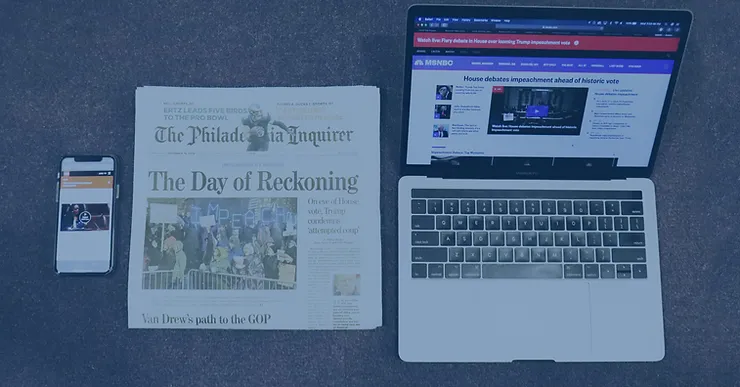
As communications strategists focused on building coalitions, driving awareness for key issues and localizing and humanizing corporate brands – we often find parallels in what we do and how political campaigns are run.
These days, for better or worse, what’s occurring in politics seems to set the trends elsewhere. And the patterns we see on the campaign trail tell us this: Get ready for a content deluge in 2020, particularly when it comes to a world increasingly reliant on social media.
Here are my key observations:
Change is constant – and you’ve got to keep up with it.
Platforms continue to alter their rules, especially when it comes to paid advertising. Twitter has banned political ads. Google won’t allow targeting based on voter files and party affiliation. Facebook has changed its disclaimers – but not gone as far as most would like to tamp down knowingly fake news.

Speaking of fake news, everyone needs to be mindful of the rise in deep fakes via artificial intelligence. This is a new and uncertain development, and it’s difficult to project how it may be used. But imagine the harm it can cause in the wrong hands – in both politics and any other form of marketing or advertising.
Content is most widely seen on social media when it is amplified through paid advertising placements. Incorporating this into your strategy is important. But the challenge will become tougher in the Presidential election cycle, particularly in a swing state like Pennsylvania. Rates will likely skyrocket and available space may be limited.
Regardless of whether you spend money on social media, it’s key to remember that people find more and more of their news online, and there is a seemingly endless amount of content for them to consume. Therefore, breaking through the clutter requires creativity and clarity.
Videos and visuals remain one of the best ways to reach people with your message. Attention spans are shrinking, so video clips need to be shorter and make the point faster.
Finding That Perfect Audience on Digital
There is more of an opportunity than ever to reach your target audience with precision. Each platform offers methods to segment its users by not just demographics but also psychographics. People’s habits, hobbies and attitudes are now part of an algorithm helping make sure your newsfeed is designed, in many ways, specifically for you.
This technology provides the opportunity to share important messages with targeted communities that are deeply impacted by an issue; to help nonprofits grow their base by contacting the most-likely donors, and to help companies and the people behind them put out some of the behind-the-scenes stories that might otherwise not be seen.
The downside of this development, of course, is that we see more and more false narratives gain momentum as emotional strings are pulled – as opposed to facts serving as the real foundation. Again, what’s happening in politics crosses over to the rest of us.
As I said, even without a paid campaign, it’s imperative to have an online presence and engage your audiences. You can’t afford NOT to be there. At the same time, don’t forget to stay in touch with local earned media, which still has a vital role in the ever-expanding content ecosystem.
Newsrooms may be shrinking, but people still trust their local news, and reporters still want to tell a good story to their audience. Take the time to build relationships with your local journalists. Understand that their inboxes are like a tidal wave, so be available and make sure your story is compelling.

Info Graphic Source: Knight Foundation
Understand, too, that your clients or customers may no longer find the daily newspaper on their doorsteps each morning or click on an outlet’s digital version regularly. It is important for you to get out in front in sharing that content with your audience. This is your story, coming from a trusted source – your local news organization. Make sure you’re part of the distribution effort.
Achieving the Goal Requires Full Integration and Creativity
We no longer live in a world where you can rely on one or two levers to connect with people on your message or issue. A smart strategy now requires everything from boots on the ground to engaging local media, connecting with trusted leaders, supporting local organizations and going online to join and lead a conversation.
It all starts with a strategy. It always has, of course, but now there are more tools in the toolbox and you have to make sure they’re all working together. Don’t overlook opportunities – from podcasts to panels to press conferences, and everything in between.
Your message should be tailored to your audience, your platform and your issue – but at its core, it never changes. Make sure you are consistent in standing for what you always stood for. And, when well executed, your campaign will tie back to your original message and achieve the goal you set forth in the beginning.
Always Stand Prepared to React
A final point: You have to be prepared for everything. News cycles can no longer handle the volume of content and information flowing every hour, every minute. Sometimes, the narrative changes before a story is even read. That means your team needs to be ready to react and respond at a quicker pace than ever to potential false claims or unforeseen developments.
The politics of our nation play out on social media every day. The 2020 election provides a view into the strategies of dozens of candidates and just as many rapidly changing issues. It is impossible to ignore, so we ought to use this tsunami as an opportunity to give us fresh insight on what works and what doesn’t. Because at the heart of it all, it’s still how we connect with people.
At Ceisler Media, we are watching the trends, having the conversations. We know it will take even more creativity in 2020 and we’re ready for it. Are you?




